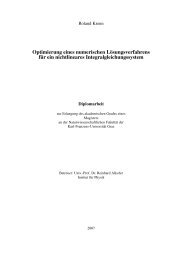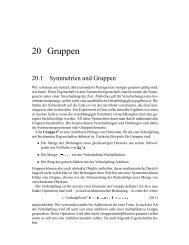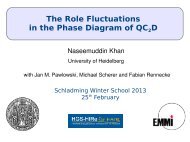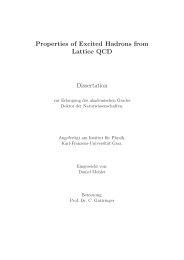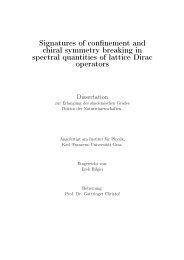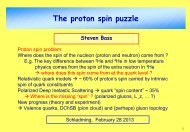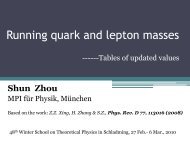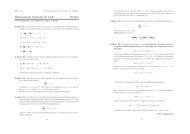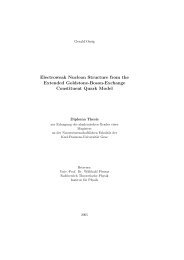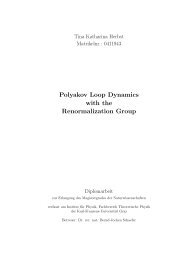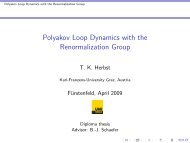The QCD Quark Propagator in Coulomb Gauge and - Institut für Physik
The QCD Quark Propagator in Coulomb Gauge and - Institut für Physik
The QCD Quark Propagator in Coulomb Gauge and - Institut für Physik
You also want an ePaper? Increase the reach of your titles
YUMPU automatically turns print PDFs into web optimized ePapers that Google loves.
Chapter 4<br />
<strong>The</strong> <strong>Quark</strong> Dyson-Schw<strong>in</strong>ger<br />
Equation<br />
In this chapter we can use the <strong>in</strong>sight we ga<strong>in</strong>ed <strong>in</strong> the last one. <strong>The</strong> profit concerns<br />
ma<strong>in</strong>ly the parametrization of the gluon propagator. Its all-dom<strong>in</strong>ant part is the <strong>Coulomb</strong><br />
potential, for which we employ an analytic ansatz. We start by deriv<strong>in</strong>g the quark Dyson-<br />
Schw<strong>in</strong>ger equation with two different methods. We solve it numerically <strong>in</strong> two different<br />
truncations <strong>and</strong> compare the results.<br />
4.1 From the <strong>QCD</strong> action to the gap equation<br />
In this section we derive the quark Dyson-Schw<strong>in</strong>ger equation from the <strong>QCD</strong> action.<br />
Because this is not rigorously possible <strong>in</strong> <strong>Coulomb</strong> gauge, we choose for this demonstration<br />
a l<strong>in</strong>ear covariant gauge <strong>and</strong> Euclidean space-time 1 .<br />
<strong>The</strong> start<strong>in</strong>g po<strong>in</strong>t is the renormalised Lagrangian [AS01], which reads<br />
(<br />
−∂ 2 δ µν −<br />
L <strong>QCD</strong> = Z 3<br />
1<br />
2 Aa µ<br />
( 1<br />
Z 3 ξ − 1 )<br />
∂ µ ∂ ν<br />
)<br />
A a ν<br />
+ ˜Z 3 ¯c a ∂ 2 c a + ˜Z 1 gf abc ¯c a ∂ µ (A c µ cb ) − Z 1 gf abc (∂ µ A a ν ) Ab µ Ac ν (4.1)<br />
+ Z 4<br />
1<br />
4 g2 f abe f cde A a µA b νA c µA d ν + Z 2 ¯q ( − ∂/ + Z m m ) q − Z 1F ig ¯qγ µ t a q A a µ .<br />
Employ<strong>in</strong>g the usual notation for the quark, gluon <strong>and</strong> ghost fields <strong>and</strong> us<strong>in</strong>g the notation ξ<br />
for the gauge parameter, this equation def<strong>in</strong>es all multiplicative renormalisation constants.<br />
In the partiton function of course the source terms<br />
A a µ ja µ<br />
1 Appropriately we use the conventions <strong>in</strong> A.2 .<br />
+ ηq + qη + σc + cσ (4.2)<br />
35



